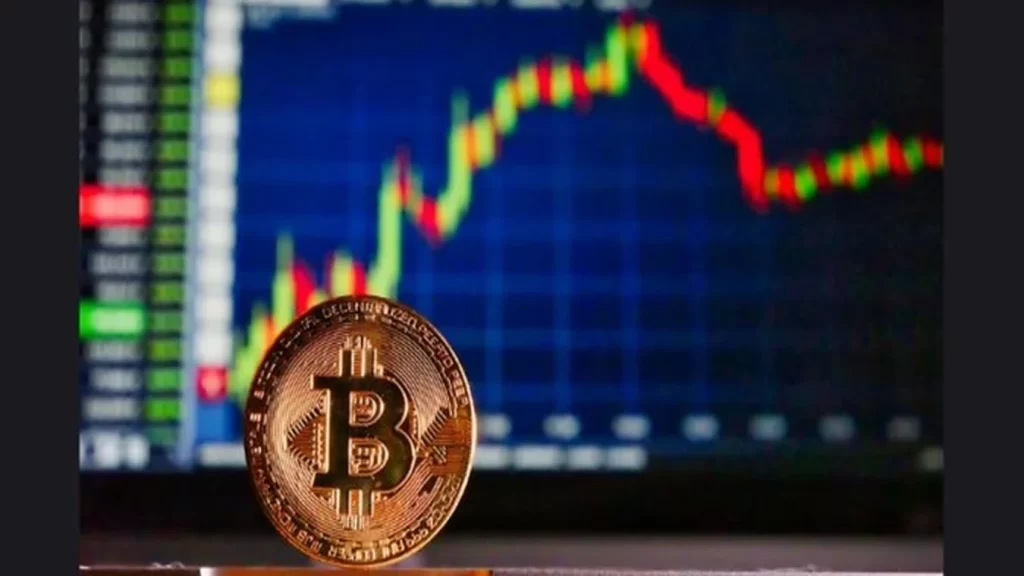Bitcoin’s recent price movements have raised concerns among traders and analysts, with many predicting that the cryptocurrency may experience further declines. Investor sentiment has dropped to levels not seen in three years, increasing the likelihood of a correction toward the $72,000 range.
As market uncertainty grows, many are questioning whether Bitcoin’s current downturn is just a temporary pullback or the beginning of a more prolonged bearish trend.
Bitcoin’s Decline from Recent Highs
Bitcoin has seen a significant drop from its all-time high earlier this year. After reaching a peak of over $109,000 in January, the cryptocurrency has fallen to around $78,000, marking a substantial pullback. This decline has been driven by several factors, including increased market volatility, profit-taking by investors, and concerns about regulatory developments in the cryptocurrency space.
Despite attempts to regain momentum, Bitcoin has struggled to maintain key support levels. Some analysts believe that the next major support zone lies around $72,000, where buying pressure could emerge. However, if this level fails to hold, the market could see even steeper declines in the short term.
Weakening Investor Sentiment
One of the key indicators influencing Bitcoin’s recent price movement is investor sentiment, which has dropped to its lowest level since 2022. The Crypto Fear & Greed Index, a popular metric for measuring market emotions, has fallen to extreme fear levels, suggesting that traders are becoming increasingly cautious.
Several factors have contributed to this negative sentiment. The broader macroeconomic environment remains uncertain, with concerns about inflation, interest rate hikes, and potential economic slowdowns affecting risk assets like Bitcoin. Additionally, fears of increased regulatory scrutiny in major markets have made institutional investors hesitant to commit large amounts of capital to the cryptocurrency sector.
Impact of Market Events and Security Concerns
Security breaches and major hacks have also played a role in dampening investor confidence. The cryptocurrency market has recently witnessed high-profile incidents involving stolen funds, further fueling concerns about exchange security and the vulnerability of digital assets.
The impact of these security issues has extended beyond individual platforms, affecting the overall trust in the market. Many investors have responded by moving their funds to self-custodial wallets or reducing their exposure to riskier assets, contributing to the ongoing price decline.
Potential Scenarios for Bitcoin’s Price Movement
With Bitcoin facing a critical moment, analysts are divided on what comes next. If the $72,000 support level holds, Bitcoin could see a period of consolidation before attempting another rally. Historically, strong corrections have often been followed by significant rebounds, as long-term investors take advantage of lower prices to accumulate more Bitcoin.
On the other hand, if Bitcoin fails to maintain support above $72,000, a deeper correction could occur. Some bearish projections suggest that Bitcoin could test lower levels before finding a new equilibrium.
Long-Term Outlook Remains Positive
Despite the current downturn, many market participants remain optimistic about Bitcoin’s long-term prospects. Historically, periods of extreme fear and price corrections have been followed by strong recoveries, particularly as adoption and institutional interest continue to grow.
As the market navigates this period of uncertainty, traders and investors will be closely watching key technical levels and broader macroeconomic trends to determine Bitcoin’s next move. While short-term volatility may persist, the fundamental case for Bitcoin remains strong, with continued advancements in adoption, infrastructure, and regulatory clarity shaping its long-term trajectory.
Bitcoin has rebounded from its recent sell-off, climbing back to the $80,000 range and briefly touching $85,000. This price movement is largely driven by an increase in spot buying and leveraged long positions. Despite the bullish momentum, some analysts warn that further downside risks still exist, and the market may not have found its true bottom yet.
Spot and Margin Longs Drive Price Recovery
One of the key factors behind Bitcoin’s price recovery has been the surge in spot market demand. Large bids have been placed on major exchanges, signaling strong buying interest at these levels.
Additionally, traders using margin and leveraged positions have contributed to the upward movement. This dynamic has resulted in a temporary shift in momentum, giving Bitcoin the support it needed to bounce back from its previous losses.
Caution as Market Conditions Remain Uncertain
Despite the recent gains, some market participants remain cautious. Many traders believe this recovery could be an oversold bounce rather than the beginning of a sustained rally. If buyers fail to maintain control and selling pressure returns, Bitcoin could revisit lower support levels.
Furthermore, macroeconomic factors and regulatory developments continue to influence investor sentiment. Any negative news could trigger another wave of selling, leading to further price corrections.
Technical Indicators and Market Structure
Bitcoin’s technical indicators present a mixed picture. While the recent rebound has pushed prices higher, the overall trend remains uncertain. The market has yet to establish a clear higher high on the daily timeframe, which would be necessary to confirm a bullish reversal.
The Relative Strength Index (RSI) has climbed from oversold levels, suggesting that selling pressure has eased for now. However, if Bitcoin fails to hold above key support zones, another downward move could be on the horizon.
What’s Next for Bitcoin?
While Bitcoin’s price action has improved in the short term, the broader market trend remains uncertain. If buying pressure continues, the cryptocurrency could attempt to consolidate above key levels, paving the way for further gains.
On the other hand, if Bitcoin struggles to maintain its momentum, traders should prepare for potential retests of lower support zones. The coming weeks will be critical in determining whether this recovery is the beginning of a new uptrend or just a temporary relief rally in a broader correction phase.
The initial surge in Bitcoin’s price following recent political shifts has subsided, leading traders and investors to refocus on macroeconomic factors. The market is now turning its attention to potential Federal Reserve policy changes, particularly interest rate cuts and monetary expansion.
Bitcoin’s Shift from Political Sentiment to Economic Drivers
During certain political transitions, Bitcoin experienced increased speculation, with investors associating policy changes with favorable conditions for cryptocurrency markets. However, this trend has diminished as broader economic factors take precedence.
The Federal Reserve’s monetary policy decisions, particularly regarding interest rates and liquidity expansion, are now at the forefront of Bitcoin’s market movement. Traders are closely monitoring signals that could indicate shifts in economic conditions that may impact Bitcoin’s trajectory.
Federal Reserve Rate Cuts and Their Impact on Bitcoin
A potential reduction in interest rates could lead to increased capital inflows into risk assets, including Bitcoin. Lower rates typically make borrowing cheaper and encourage investment in alternative assets. Additionally, an expansion of the money supply could drive further demand for Bitcoin as a hedge against inflation.
Liquidity Expansion and Bitcoin’s Market Response
Beyond interest rate policies, the Federal Reserve’s approach to liquidity expansion will also play a role in Bitcoin’s price movement. If the central bank increases liquidity to support economic growth, Bitcoin could see renewed demand from institutional investors looking for alternative stores of value.
Conclusion
As political speculation surrounding Bitcoin fades, macroeconomic factors such as Federal Reserve policies on interest rates and liquidity expansion will become the primary drivers of market sentiment. Investors should pay close attention to these economic developments as they navigate Bitcoin’s evolving landscape.
The idea of governments holding Bitcoin as a strategic reserve has moved from speculation to serious discussion. Some U.S. states are now considering adopting Bitcoin reserves before the federal government takes similar action.
State-Level Bitcoin Adoption
Certain states have taken legislative steps toward establishing Bitcoin reserves. Some are in the final stages of approving bills that would allow state treasuries to hold Bitcoin as part of their reserves. Others have initiated discussions on how integrating Bitcoin into state financial systems could provide a hedge against inflation and economic instability.
However, not all states have embraced the idea. Several have rejected proposals related to Bitcoin reserves, highlighting concerns over volatility and regulatory uncertainty. This divide showcases the varying perspectives on cryptocurrency adoption within the U.S.
Federal Government’s Stance on Bitcoin Reserves
At the federal level, discussions around Bitcoin reserves have been more measured. Recent executive orders have explored the feasibility of a national Bitcoin stockpile, with some officials advocating for a sovereign wealth fund that includes digital assets.
Despite these developments, state governments are likely to move faster than the federal government in adopting Bitcoin reserves. The decentralized nature of state decision-making allows for more rapid policy changes, potentially setting a precedent for broader national adoption in the future.
Implications for Bitcoin Adoption
If states begin incorporating Bitcoin into their reserves, it could have significant implications for the cryptocurrency market. Increased governmental adoption could:
- Strengthen Bitcoin’s legitimacy as a store of value
- Influence future regulatory frameworks
- Encourage institutional investors to increase their exposure to digital assets
Conclusion
As some states lead the charge in integrating Bitcoin into their financial strategies, they may set the stage for broader adoption at the national level. While the federal government remains cautious, the momentum at the state level suggests that Bitcoin’s role in governmental reserves could expand in the near future.
The sudden collapse of cryptocurrency exchange FTX in November 2022 created turmoil in the crypto market. Once valued at $32 billion, FTX’s downfall was attributed to allegations of misusing customer funds to support its affiliated trading firm, Alameda Research. This led to a liquidity crisis, preventing customers from accessing their assets and culminating in a Chapter 11 bankruptcy filing.
Initiation of Creditor Repayments
In February 2025, FTX began its first round of creditor repayments, with a second round scheduled for later in the year. Creditors eligible for the next phase must verify their claims before receiving payments. Under the exchange’s recovery plan, the majority of affected users are expected to receive more than 100% of their claims in cash.
Industry Reactions and Expert Opinions
Industry analysts believe that the two-year repayment timeline, despite initial frustration, should be viewed as a positive outcome. Many had anticipated a much longer legal battle due to the complexities involved, including multiple jurisdictions, regulatory barriers, and legal negotiations.
Challenges in the Repayment Process
FTX’s multinational operations complicated the repayment process, requiring coordination across various legal systems. These jurisdictional challenges added layers of complexity, making the relatively swift resolution surprising to many.
Impact on Creditors and Market Sentiment
The repayment process has offered some relief to creditors and is seen as a step toward restoring confidence in the crypto industry. The ability to distribute funds relatively quickly, despite the scale of the collapse, demonstrates a level of accountability that is often lacking in similar cases.
Lessons Learned and Future Implications
The downfall of FTX has underscored the importance of transparency, regulatory oversight, and proper risk management for cryptocurrency exchanges. These developments could pave the way for stronger industry regulations and increased scrutiny over centralized platforms.
While the collapse was a significant blow, the expedited repayment process is being regarded as a sign that structured recovery efforts can yield positive results in the face of financial disasters.
Bitcoin has recently surged to $85,000, fueled by a combination of strong spot buying and aggressive margin longs. This upward momentum has given investors renewed confidence in the market. However, analysts caution that despite the rally, market indicators suggest the bottom may not yet be fully established.
The Role of Spot and Margin Buying
A significant portion of Bitcoin’s latest rally has been attributed to strong spot buying, as well as leveraged margin longs. Market participants have shown a growing appetite for risk, pushing prices higher despite broader market uncertainties. The influx of institutional interest has also played a role in the price spike, with large buyers accumulating positions amid market optimism.
Potential Risks of Overleveraging
While the rally has been impressive, there are concerns about overleveraging. High levels of margin trading can lead to sudden liquidations, which may trigger sharp corrections in Bitcoin’s price. If long positions become overextended, a market downturn could wipe out gains and create increased volatility.
Macro Factors and Market Sentiment
External economic factors, including inflation concerns, monetary policy shifts, and global financial uncertainty, continue to play a role in Bitcoin’s price trajectory. Investors are watching central bank policies closely, as changes in interest rates and liquidity conditions could impact risk appetite in the crypto space.
Key Support and Resistance Levels
Analysts point to key technical levels that will determine Bitcoin’s next moves. If the asset fails to sustain momentum above the $85,000 mark, a pullback to lower support levels could be likely. Conversely, a breakout past resistance could pave the way for further gains, potentially pushing Bitcoin to $100,000 and into new all-time highs.
Caution Amid Bullish Momentum
Despite the optimism surrounding Bitcoin’s latest surge, experts urge caution. The market remains highly volatile, and traders should be prepared for potential corrections. While long-term sentiment remains positive, short-term fluctuations are expected, making risk management essential for those looking to capitalize on the current trend.
Final Thoughts
Bitcoin’s rally to $85,000 highlights strong demand and growing institutional participation. However, with leveraged positions rising and external macroeconomic factors at play, the market remains uncertain. Investors should stay vigilant, considering both the bullish momentum and the potential risks that could lead to sudden market reversals.
Bitcoin (BTC) has recently experienced a significant price decline, falling more than 6.5% in the past 24 hours to a low of $78,197, a level not seen since November 2024. This downturn is largely attributed to escalating trade tensions between the United States and China, following U.S. President Donald Trump’s decision to impose import tariffs. The potential for a trade war has heightened investor concerns, leading to increased market volatility and a reassessment of risk assets, including cryptocurrencies.
Impact of Trade Tensions on Bitcoin
The imposition of tariffs by the U.S. government has introduced uncertainty into global markets. Investors fear that retaliatory measures from China could exacerbate economic instability, prompting a shift away from riskier assets. Bitcoin, often perceived as a hedge against traditional financial systems, has not been immune to these macroeconomic pressures. The correlation between Bitcoin’s price movements and global economic events underscores its sensitivity to broader market dynamics.
Technical Analysis: Key Support Levels
Analysts are closely monitoring Bitcoin’s price action, particularly the critical support level at $75,000. Ryan Lee, chief analyst at Bitget Research, notes that losing this support could open the door to further declines, potentially targeting the $70,000 region. Historical patterns and trader sentiment suggest that maintaining support above $75,000 is crucial for preventing deeper corrections. A breach of this level may trigger additional selling pressure, as traders seek to mitigate potential losses.
Historical Context and Future Projections
Historically, Bitcoin has undergone periods of significant volatility, often influenced by macroeconomic events. The current correction mirrors previous downturns, where external factors prompted sharp sell-offs. Raoul Pal, founder and CEO of Global Macro Investor, previously indicated that Bitcoin could reach a “local top” above $110,000 in January before entering a corrective phase. This projection aligns with the recent price movements, suggesting that Bitcoin’s trajectory is influenced by a combination of technical factors and macroeconomic developments.
Market Sentiment and Investor Behavior
The prevailing market sentiment has shifted towards caution, with investors closely monitoring geopolitical developments and their potential impact on financial markets. The possibility of a prolonged trade dispute between major economies has introduced a risk-off sentiment, leading to reduced exposure to volatile assets like cryptocurrencies. This cautious approach is reflected in trading volumes and the increased demand for traditional safe-haven assets.
Conclusion
Bitcoin’s recent price decline highlights its susceptibility to global economic events, particularly escalating trade tensions between the U.S. and China. The critical support level at $75,000 serves as a focal point for traders and investors. A sustained breach below this threshold could precipitate further declines, while stabilization above it may restore confidence and attract renewed interest. As the situation evolves, market participants are advised to stay informed about geopolitical developments and adjust their strategies accordingly to navigate the inherent volatility of the cryptocurrency market.
The Arizona Senate has recently passed two significant bills aimed at integrating cryptocurrencies into the state’s financial framework. These bills, which propose the establishment of a state cryptocurrency reserve, mark a major step toward incorporating digital assets into state-level financial planning. If enacted, Arizona would become one of the first U.S. states to officially recognize cryptocurrency as part of its financial reserves.
The Proposed Cryptocurrency Reserve
The primary objective of these bills is to enable the Arizona State Treasurer to manage and hold cryptocurrency as part of the state’s financial reserves. This move would allow the government to diversify its financial holdings, potentially leveraging digital assets to enhance the stability and liquidity of state funds.
Under the proposed legislation, the state would be permitted to store a variety of cryptocurrencies, including Bitcoin (BTC), Ethereum (ETH), and other approved digital assets. The bills outline a framework for securely storing and managing these holdings while ensuring compliance with existing financial regulations.
Legislative Progress and Support
The bills, Senate Bill 1235 and Senate Bill 1236, were passed with strong support from lawmakers advocating for Arizona’s leadership in blockchain and cryptocurrency adoption.
State Senator Wendy Rogers, a vocal proponent of the legislation, emphasized the importance of embracing digital assets as part of the financial future. She stated, “Arizona has the opportunity to position itself at the forefront of financial innovation by recognizing the role of cryptocurrencies in our economic system.”
While the bills have cleared the Senate, they must now pass through the House of Representatives before being signed into law by the governor.
Potential Impact on Arizona’s Economy
If the legislation is approved, Arizona could become a key player in the growing cryptocurrency ecosystem. Supporters argue that adopting crypto as part of the state’s reserves could attract blockchain-based businesses and investment, potentially stimulating economic growth.
Moreover, the move aligns with broader trends in digital asset adoption by governments and financial institutions worldwide. Countries such as El Salvador have already incorporated Bitcoin into their financial systems, and several U.S. states are exploring similar policies.
Challenges and Concerns
Despite its potential benefits, the proposal has also faced opposition from some lawmakers and financial experts. Critics argue that cryptocurrencies remain highly volatile and pose risks to state finances. The fluctuating nature of digital asset prices could result in significant financial losses if the market experiences downturns.
Additionally, regulatory uncertainty at the federal level presents another challenge. The U.S. government has yet to establish a clear regulatory framework for state-held cryptocurrencies, and potential changes in federal policy could impact Arizona’s ability to implement its crypto reserve.
The Road Ahead
With the bills now progressing to the House of Representatives, lawmakers will continue debating the potential risks and rewards of a state-managed cryptocurrency reserve. If approved, Arizona could set a precedent for other states considering similar measures.
The move also reflects a broader shift in attitudes toward cryptocurrency at the governmental level. As digital assets become more widely accepted, Arizona’s approach could serve as a model for integrating blockchain technology into public financial systems.
Conclusion
Arizona’s proposed cryptocurrency reserve legislation represents a significant step toward mainstream adoption of digital assets. While the initiative has garnered both support and criticism, its potential impact on the state’s economy and financial strategy cannot be overlooked. As the bills move through the legislative process, all eyes will be on Arizona to see whether it becomes the first U.S. state to hold cryptocurrency as part of its official financial reserves.
In the wake of a significant cryptocurrency market correction, Binance, the world’s largest cryptocurrency exchange, has found itself at the center of speculation regarding its token holdings. Social media platforms have been abuzz with claims that Binance has been offloading substantial amounts of various cryptocurrencies, including Solana (SOL). These assertions have emerged following notable market movements and large-scale token transfers, leading to widespread concern among investors.
Market Downturn and Emergence of Speculation
The cryptocurrency market recently experienced a sharp downturn, with Bitcoin’s (BTC) price dipping to a low of $78,197, a level not seen since November 2024. This decline has been attributed to a combination of factors, including macroeconomic uncertainties and significant security breaches, such as the $1.4 billion Bybit hack. Amid this volatile environment, rumors began circulating that major exchanges, particularly Binance, were contributing to the sell-off by liquidating large portions of their token reserves.
Binance’s Response to Allegations
In response to these claims, Binance has categorically denied any involvement in mass selling of tokens. A spokesperson for the exchange stated, “Binance hasn’t ‘dumped’ or ‘sold’ large amounts of tokens as some tweets have wrongly claimed.” The spokesperson emphasized that such allegations stem from a fundamental misunderstanding of Binance’s role in the cryptocurrency ecosystem, clarifying, “They are misunderstanding what Binance does as an exchange, which is we simply help users match trades.”
Understanding Exchange Operations and Market Maker Activities
The confusion appears to arise from the misinterpretation of large token movements associated with market makers and liquidity providers. Market makers play a crucial role in ensuring liquidity and smooth trading experiences on exchanges by facilitating buy and sell orders. These entities often move substantial amounts of cryptocurrencies to and from exchanges as part of their regular operations. For instance, data from Arkham Intelligence revealed that Wintermute, a prominent crypto market maker, withdrew over $38.2 million worth of Solana from Binance within a 24-hour period leading up to February 24. Such movements are standard practice for market makers managing liquidity and do not necessarily indicate bearish sentiment or impending sell-offs.
Bitcoin (BTC) has had a strong start to 2025, but according to analysts at Matrixport, the cryptocurrency may be heading for a short-term correction in the coming months. The financial services firm suggests that BTC’s historical patterns indicate a potential price decline in March and April before resuming its upward trajectory.
Bitcoin’s Strong Rally and Potential Pullback
Optimism surrounding the approval of spot Bitcoin ETFs in the United States and renewed institutional interest have contributed to this bullish momentum. However, history suggests that March and April could bring a temporary pause in BTC’s upward movement.
Matrixport analysts point out that Bitcoin has historically shown weakness during these months, often retracing before entering a stronger rally later in the year. “The data suggests that Bitcoin’s performance tends to dip during this period before resuming its bull run,” the firm stated in its latest report.
Historical Trends and Seasonal Weakness
A closer look at Bitcoin’s past price movements reveals that March and April have often been marked by corrections. In previous bull cycles, BTC has experienced temporary pullbacks before setting new highs.
For instance, in 2021, Bitcoin surged to over $60,000 in early March before retracing to around $50,000 by April. A similar trend was observed in 2017 when BTC saw a correction in March before rallying to record highs later that year.
While history does not always repeat itself exactly, analysts believe that these seasonal patterns are worth considering when evaluating Bitcoin’s short-term outlook.
Potential Catalysts for a Correction
Several factors could contribute to a potential pullback in Bitcoin’s price over the next couple of months. One key element is market liquidity, which has been affected by recent regulatory developments and macroeconomic trends.
Additionally, profit-taking by institutional investors could lead to temporary sell-offs. With Bitcoin’s price having climbed significantly in recent months, some investors may look to lock in gains, leading to short-term downward pressure.
Another potential factor is increased scrutiny from regulators, particularly in the U.S. Following the approval of Bitcoin ETFs, regulatory agencies may impose stricter oversight, impacting market sentiment and investor behavior.
Long-Term Outlook Remains Bullish
Despite the potential for a short-term correction, Matrixport remains optimistic about Bitcoin’s long-term prospects. The firm believes that any dip in the coming months could present a buying opportunity for investors looking to enter the market ahead of another major rally.
“We see this as a normal part of Bitcoin’s market cycle,” the report stated. “A correction in March or April could be followed by a renewed surge in the second half of the year, especially as institutional demand continues to grow.”
What Investors Should Watch For
As Bitcoin approaches a potential correction phase, investors should closely monitor key support levels. A drop below $70,000 could signal further downside, while maintaining strength above this level would indicate resilience in the market.
Additionally, traders should keep an eye on macroeconomic factors, including Federal Reserve policy decisions and broader financial market trends. Any significant shifts in interest rates or inflation data could influence Bitcoin’s trajectory.
For long-term holders, a short-term correction may not be a cause for concern. Many analysts see Bitcoin’s long-term trend as bullish, particularly with increasing institutional adoption and the upcoming Bitcoin halving event in 2026.
Conclusion: Temporary Dip or Buying Opportunity?
While Matrixport’s analysis suggests that Bitcoin could face a correction in March and April, the overall outlook for the year remains positive. If historical trends hold true, any dip during this period could be followed by a strong rally in the latter half of 2025.
Investors should remain cautious, stay informed about market developments, and consider long-term strategies rather than reacting to short-term fluctuations. Whether the expected pullback materializes or not, Bitcoin’s fundamental growth story continues to attract attention from retail and institutional investors alike.










